ONDC stands for Open Network for Digital Commerce – an innovative concept brought to fruition to enable businesses to connect directly with end users regardless of the platform. ONDC India will collect and display all available products and services, listed on multiple platforms, with the click of a search button.
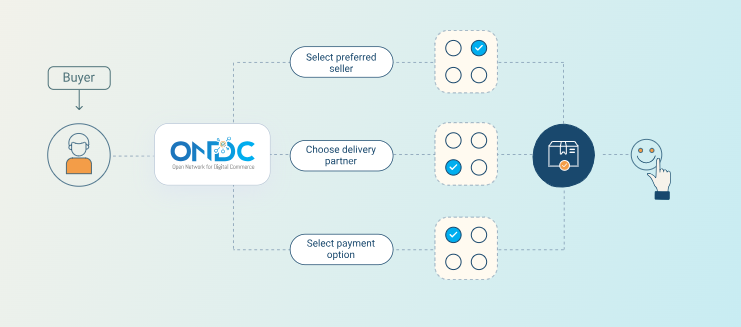
Image Source: Ondc website.org
This disruptive technology aims to consolidate the online marketplace by creating a level playing field for all retailers. As an open-network platform, it allows for higher discoverability of products and promotes neutrality for both sellers and buyers.
The novel idea can be compared with the Indian UPI system that integrates banking partners with corporate businesses, local retailers, and users directly via their mobile numbers. ONDC will follow a similar setup wherein platforms are connected to the ONDC network on the backend, showcasing a single unified interface to the user.
eCommerce in India has seen exponential growth in the last decade, expected to reach 300-350 million shoppers and India’s online Gross Merchandise Value (GMV) is projected to reach $ 100-120 billion by 2025. This data is quite promising for any new business seeking to enter the eCommerce space and for existing brands currently operating online.
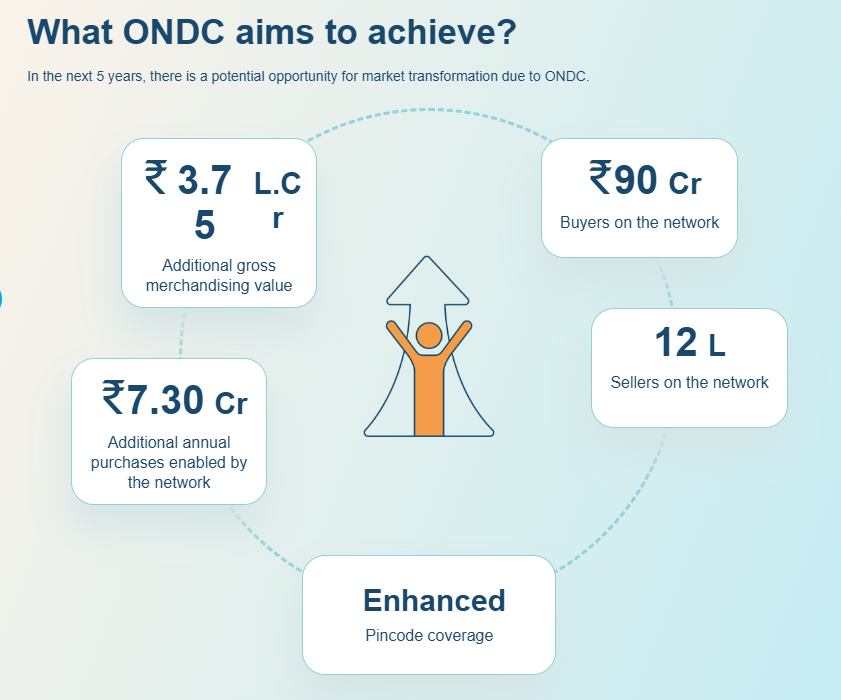
The ONDC India initiative which began at the end of 2021, solves several challenges new brands – especially small businesses – face when they enter the eCommerce space. Gaining visibility in a market saturated with products poses immense hurdles when factoring in the monopoly platforms like Amazon and Flipkart have over online retail.
ONDC Integration in the Online Marketplace
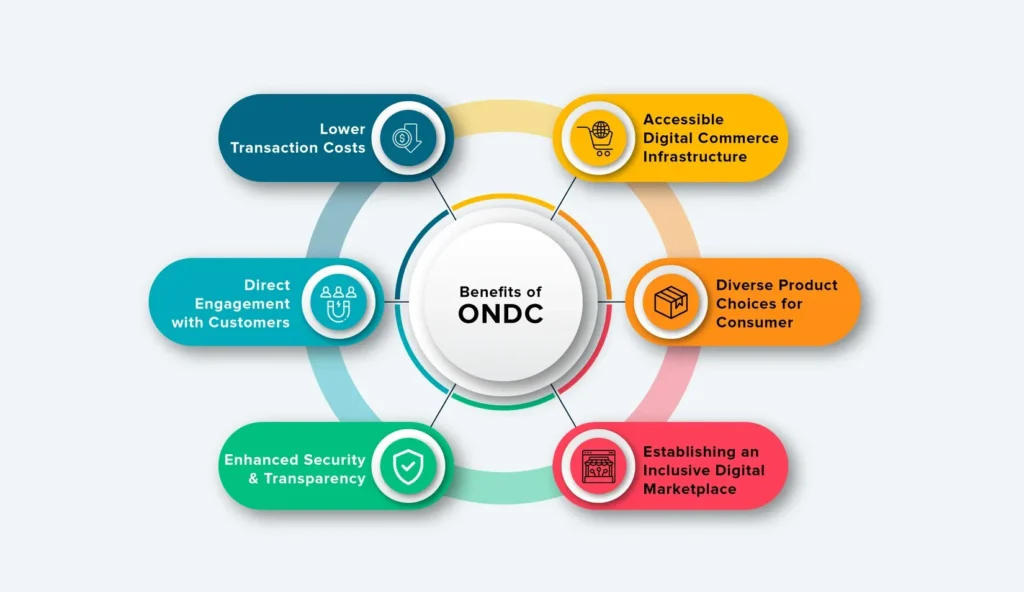
The ONDC concept will function via buyer and seller applications. Buyer applications – food delivery, cab hailing, and eCommerce – catering to different products and service requirements will all be connected to the same framework. Once the user enters a search term, relevant results from all ONDC-connected seller applications will be consolidated and displayed to the user. This system is depicted by the ONDC architecture chart created by Inc4.
eCommerce giant Paytm has already been onboarded with ONDC as a buyer application. For sellers, Gofugal, Digiit, eSamudaay, and Growth Falcon have been chosen so far. Other logistics platforms include Dunzo and Loadshare, with more sellers and logistic partners yet to join. Currently, in its preliminary stages, ONDC will see explosive growth in the years to come, expecting to onboard over 60 million small businesses to the platform.
How Indian eCommerce Brands Stand to Benefit from ONDC
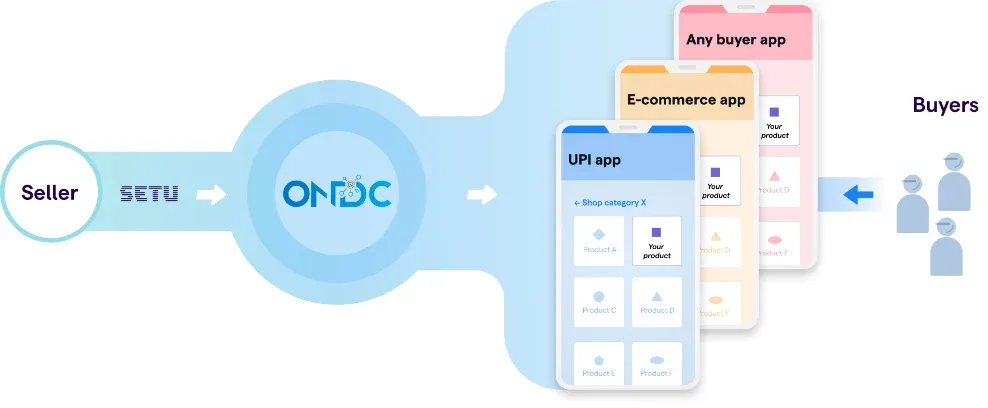
Image Source: Daffodil Insights
While there are pros and cons to adopting any disruptive technology, ONDC is a boon to several small retailers struggling to market their products. With the interest and backing of top market players such as Amazon, Flipkart, and Snapdeal, it’s evident that the implementation of ONDC isn’t a replacement maneuver but an enhancement measure.
Discoverability & Transparency
This comes as no surprise that once product search results are displayed on a unified platform, it allows for superior price and vendor discovery. Cataloging items on multiple platforms and showcasing them on a unified application will help several unseen products get discovered.
Transparency also becomes easier as sellers can compare the prices of products so that they don’t over or undervalue their items. Since the platform is also backed by multiple government entities, vendors can rest assured that they aren’t getting stuck with the short end of the stick.
Growth Opportunities
Growth and discoverability are intertwined. When products appear in more search results, it increases brand awareness and thus the potential for growth. In an interconnected ONDC platform, vendors will have visibility and access to a plethora of products and services; this can drastically reduce the time for market penetration and improve the time-to-scale.
Prevents Anti-Competitive Behaviors
A major grey area that impacted many businesses was the promotion of preferred sellers by certain large eCommerce platforms. Amazon being one of them, faced severe backlash as the algorithm promoted its own subsidiary brands and buried other sellers under heaps of results, killing off the competition.
Having access to ecommerce data on best-performing items, customer sentiments on merchandise, and knowledge of how well a product sells, any platform can create its own similar line, promote it, and divert all traffic to that product – which has happened in the past.
The adoption of ONDC puts a stop to such anti-competitive behaviors by creating an impartial platform for all to use.
Supply Chain Integration
One of the main concerns of a small business operating on its own is to find the right logistic partner to deliver items without charging a high amount per order. Established brands sending upwards of 100-200 products a day, do not feel the plight of finding the right logistic partner the way an up-and-coming company does.
When sellers and logistic partners are all interconnected on a single platform, it becomes much easier for businesses – especially small ones to seamlessly deliver their products to customers. As an interlinked operation, logistics also becomes easier in terms of pricing that benefits all parties.
Neutral Playing Field
When there’s a monopoly in the market in sectors such as eCommerce, food delivery, and transportation, it becomes almost impossible for new players to join and start operations. For example, in the food delivery industry, Zomato and Swiggy have dominated the market for years. In the transportation sector, Uber and Ola have been pioneers.
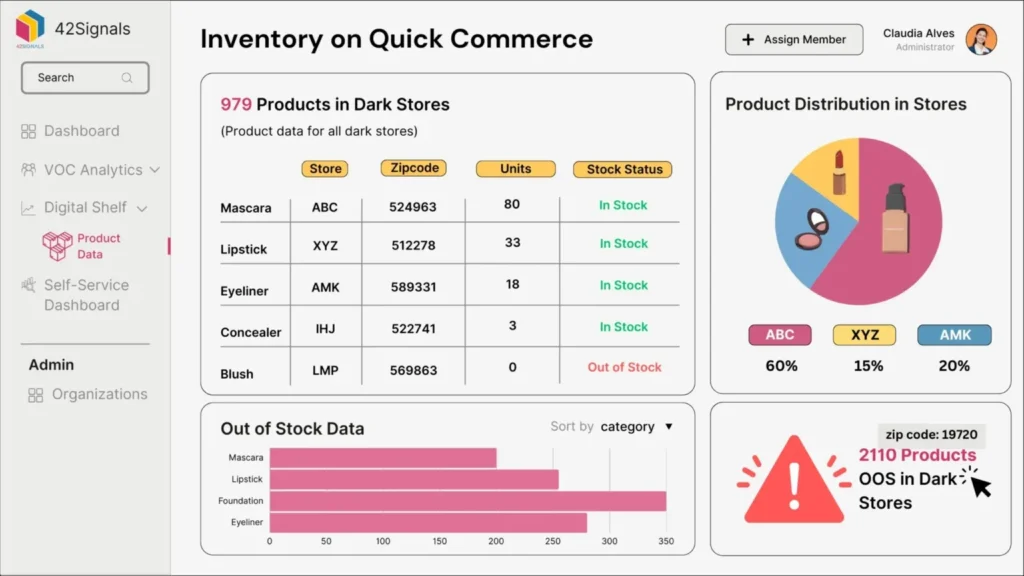
Any company or individual seeking to grow their business must abide by the rules imposed by these platforms and pay their service fees. That may leave very slim to no profits for the owners if the monthly revenue is just enough to cover costs. With ONDC, anybody can offer their products or services and successfully run their business on a neutral playing field.
Conclusion on ONDC in India
ONDC has several benefits that can create a positive impact on India’s eCommerce sector. It also aids in the progress of digital transformation that India is currently on the path to achieving.
The onset of a unified system creates several opportunities for small businesses to function in some of the rural areas of the country. They lack the infrastructure and capital to create their own ecosystem; help from the government – especially some of the smartest brains creating the platform – can swiftly put an end to their problems.
Frequently Asked Questions
How can I access the ONDC platform?
- As a Buyer: To shop on the ONDC network, you can use any participating buyer application. These apps connect you to a wide range of sellers and products across various categories.
- As a Seller: To sell on the ONDC network, you need to register through a seller network participant. This involves digitizing your product catalog and integrating it with the ONDC protocols.
Who owns ONDC in India? ONDC is a non-profit organization established by the Government of India’s Department for Promotion of Industry and Internal Trade (DPIIT). It aims to democratize digital commerce by creating an open, inclusive network.
How much is the ONDC fee? While specific fee structures may vary, ONDC aims to reduce transaction costs significantly compared to traditional e-commerce platforms. The exact fees depend on various factors, including the services availed and the agreements with network participants.
Which banks are partners with ONDC? Several major banks have partnered with and invested in ONDC, including:
- State Bank of India (SBI)
- Punjab National Bank (PNB)
- Kotak Mahindra Bank
- Axis Bank
- HDFC Bank







